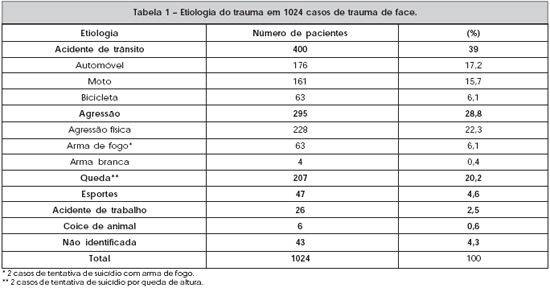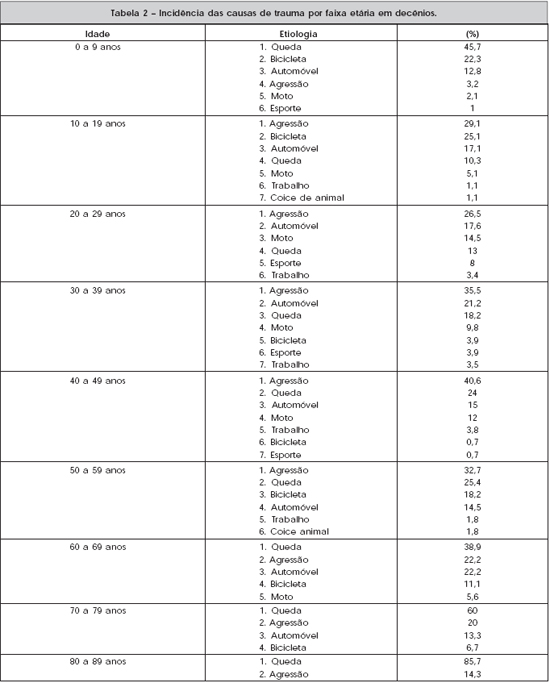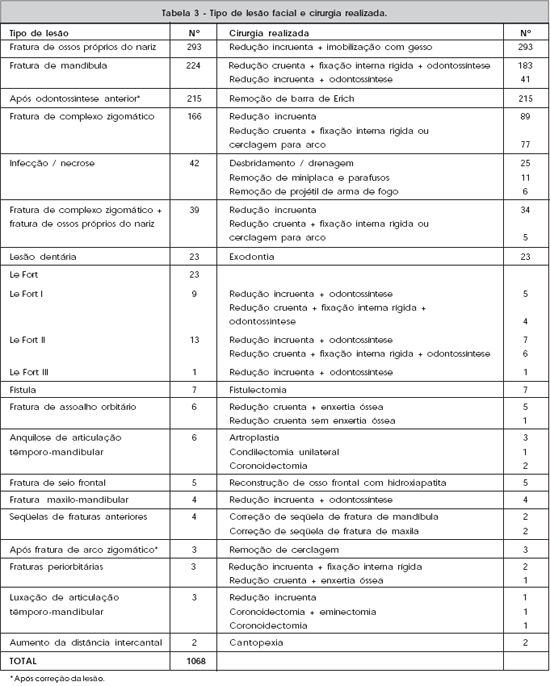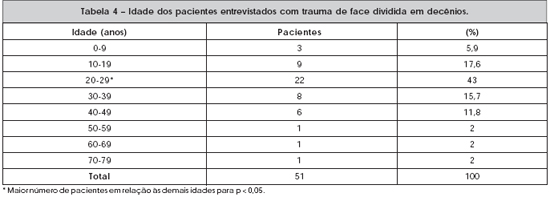

Original Article - Year 2006 - Volume 21 -
Evaluation of maxillofacial trauma at the Hospital Maria Amélia Lins of the Fundação Hospitalar do Estado de Minas Gerais
Avaliação do Trauma Bucomaxilofacial no Hospital Maria Amélia Lins da Fundação Hospitalar do Estado de Minas Gerais
ABSTRACT
Introduction: The incidence of traumatic injuries located in the face is higher than injuries in other body areas. The Hospital Maria Amélia Lins of the Fundação Hospitalar do Estado de Minas Gerais (FHEMIG) is reference for the attendance of the victims of maxillofacial traumas in Belo Horizonte. Objective: The main goal of the present work is to verify epidemiologic, etiologic, social-economic and therapeutic characteristics of maxillofacial trauma in patients treated in this institution. Method: The data were evaluated through retrospective analysis of patient charts, during the period of 2004 to 2005, including prospective, randomized interview with patients in 2006. Absolute values and percentages were described. The qui-quadrado test was utilized to compare sex and age of the patients with level of significance of 5% (p < 0.05). Results: The facial trauma etiology was in this order traffic accidents, personal violence and falls. It was observed male prevalence of 4 to 1, with ages around 20 to 29 years. In order, their skin color were white, colored and black. The most frequent lesions were nasal fracture, mandibular fracture, zigomatic complex fracture and maxillary fracture. The hospitalar permanence varied of 0 to 14 days. The treatment was similar to the preconized in the literature. Most of the patients had a low social status and a bad oral care. However, it did not affect significantly their treatment. Conclusion: The characteristics of the patients with maxillofacial trauma at the Hospital Maria Amélia Lins - FHEMIG are similar to those described in the literature.
Keywords: Maxillofacial injuries, surgery. Facial bones, injuries. Mandibular injuries
RESUMO
Introdução: A incidência de lesões traumáticas localizadas na face é elevada comparada a injúrias em outras áreas. O Hospital Maria Amélia Lins da Fundação Hospitalar do Estado de Minas Gerais (FHEMIG) é referência para o atendimento de vítimas de trauma bucomaxilofacial em Belo Horizonte. Objetivo: O principal objetivo desse trabalho foi verificar características epidemiológicas, etiológicas, socioeconômicas e terapêuticas do trauma bucomaxilofacial em pacientes atendidos nesta instituição. Método: Foi realizada análise retrospectiva de prontuários de pacientes, durante o período de 2004 e 2005, além de entrevista prospectiva e randomizada de pacientes atendidos em 2006. Os dados coletados foram descritos em valores absolutos e porcentagens. O teste qui-quadrado foi utilizado para comparar o sexo e a idade dos pacientes, sendo considerado significante um p-valor < 0,05. Resultados: A etiologia do trauma facial foi, nesta ordem, acidentes de trânsito, agressões e quedas. Houve uma prevalência masculina de 4:1, com predomínio de pacientes entre 20 e 29 anos. Com relação à cor da pele, houve prevalência de leucodérmicos, seguidos de feodérmicos e melanodérmicos. Os tipos de lesões mais encontradas foram fraturas de nariz, de mandíbula, de complexo zigomático e de maxila. O tempo de permanência hospitalar variou de 0 a 14 dias. O tratamento utilizado não diferiu do preconizado na literatura. A maioria dos pacientes apresentava baixa condição social e uma saúde bucal ruim, entretanto, isso não afetou de maneira significativa o tratamento. Conclusão: As características dos pacientes do Hospital Maria Amélia Lins com trauma bucomaxilofacial assemelham-se às descritas na literatura.
Palavras-chave: Traumatismos maxilofaciais, cirurgia. Ossos faciais, lesões. Traumatismos mandibulares
É elevado o índice de lesões traumáticas na face se comparado a injúrias em outras áreas, pois esta região do corpo está normalmente exposta, sem proteções externas. As causas do trauma bucomaxilofacial variam com a idade, sexo, condição social e localização geográfica do indivíduo. Acidentes com veículos, quedas, prática esportiva, violência pessoal e acidentes de trabalho estão entre as principais causas1. O tratamento dessas lesões visa à recuperação da função, com o mínimo de seqüela na aparência do paciente2-8.
O Hospital Maria Amélia Lins da Fundação Hospitalar do Estado de Minas Gerais (FHEMIG), em Belo Horizonte, é uma das maiores referências para o atendimento do paciente vítima de trauma bucomaxilofacial. Baseando-se em dados do serviço de arquivo médico e estatística (SAME), são atendidos por dia uma média de 40 pacientes com trauma facial no Hospital Maria Amélia Lins, o que resulta em aproximadamente 8000 atendimentos ambulatoriais por ano. Dos pacientes atendidos, cerca de 12,5% têm indicação cirúrgica. Dessa forma, são realizadas nesse serviço, anualmente, uma média de 1000 cirurgias para o trauma facial.
Este trabalho teve o objetivo de avaliar aspectos relacionados aos casos de trauma facial atendidos pelo Serviço de Cirurgia Plástica, unidade de Cirurgia do Trauma Bucomaxilofacial, da Fundação Hospitalar do Estado de Minas Gerais. Neste estudo, verificou-se, além das características epidemiológicas e etiológicas do trauma bucomaxilofacial, aspectos socioeconômicos e de saúde bucal dos pacientes atendidos nesse serviço.
MÉTODO
Este trabalho foi realizado por meio de pesquisa de prontuários do SAME, além de entrevistas e exame físico de pacientes vítimas de trauma de face, atendidos no Hospital Maria Amélia Lins (HMAL).
Foi realizada uma análise retrospectiva de 8981 prontuários, após a aprovação do Comitê de Ética em Pesquisa da FHEMIG, durante o período de 2004 a 2005. Desses, foram escolhidos aleatoriamente 1024 prontuários para se coletar os seguintes dados: sexo, etiologia do trauma e incidência das causas por faixa etária. Nesta mesma análise, identificaram-se 1068 casos cirúrgicos, nos quais se avaliou o tipo de lesão, a cirurgia realizada e a permanência hospitalar.
Por meio de entrevista, realizou-se uma avaliação prospectiva do perfil do paciente atendido nesse serviço. Em 2006, foram entrevistados 51 pacientes, escolhidos aleatoriamente. A entrevista seguiu um protocolo que considerou os seguintes aspectos: idade, sexo, cor e indicadores sociais. No exame físico, foi avaliada a dentição dos pacientes. Esta foi classificada com relação ao número de dentes em 3 categorias: (1) completa; (2) incompleta: falta de 1 a 31 dentes; (3) ausente: ausência de dentes. A exodontia dos dentes sisos não foi considerada como perda de dente. Aspectos da saúde bucal e dentição do paciente foram avaliados devido ao fato de a odontossíntese e as fixações intermaxilares serem tratamentos muito freqüentes para traumas faciais, como a fratura de mandíbula, e, ser necessária, uma dentição adequada para a sua realização.
Os dados coletados foram descritos em valores absolutos e porcentagens. O teste qui-quadrado foi utilizado para comparar o sexo e a idade dos pacientes, sendo considerado significante um p-valor < 0,05.
RESULTADOS
Na análise dos prontuários, a etiologia do trauma de face foi mais prevalente, nessa ordem: acidente de trânsito (39%), agressão (28,8%), queda (20,2%), prática de esporte (4,6%), acidente de trabalho (2,5%), coice de animal (0,6%) e causas não identificadas (4,3%) - Tabela 1. A incidência das causas citadas variou de acordo com a faixa etária. Queda foi causa principal de trauma facial nos extremos de idade. Agressão predominou dos 10 aos 59 anos de vida. Acidente de automóvel ocupou o segundo lugar entre a 3a e a 4a década de vida. Após esse período, foi superado gradativamente por quedas (Tabela 2).


Ainda na análise desses pacientes, 80,6% eram homens e 19,4% eram mulheres, em uma prevalência masculina de 4:1 (p < 0,05). Essa prevalência não diferiu entre os indivíduos entrevistados (80,4% homens e 19,6% mulheres). Quanto à cor da pele, houve predomínio de leucodérmicos (45%), seguidos de feodérmicos (33,3%) e melanodérmicos (21,6%).
Fratura de nariz foi a lesão mais encontrada (27,4%), seguida por fratura de mandíbula (20,9%) e do complexo zigomático (15,5%) - Tabela 3.

O tempo de permanência hospitalar dos pacientes variou de 0 a 14 dias, sendo que 65% receberam alta no dia da cirurgia. Os internados ficaram no hospital por 24 a 48 horas, em 70% dos casos.
A maioria dos pacientes entrevistados tinha idade inferior a 40 anos (82,2%), com uma prevalência significativa da 3a década (43%) - Tabela 4. A renda mensal da maioria (53%) dos entrevistados foi inferior a 2 salários mínimos. Do total de pacientes, 13,7% estavam desempregados e 17,6% eram estudantes. Quanto à escolaridade, 49% apresentavam o ensino fundamental incompleto. A conclusão do ensino médio foi verificada em 15,7% dos pacientes e apenas 4% realizaram outro curso após o ensino médio.

Com relação ao número de dentes, 56,9% dos pacientes apresentaram a dentição incompleta e 5,9%, ausência de dentição. Uma dentição completa foi encontrada em 37,2% dos pacientes. Devido ao trauma, 23,5% perderam dentes, já a mobilidade de dentes foi encontrada em 9,8%. Apenas 28% dos pacientes com perda de dentes usavam prótese (fixa, parcial removível ou total removível). A fixação externa através de odontossíntese e bloqueio maxilo mandibular foi necessária em 53% dos casos, porém 2 pacientes com esta indicação não foram submetidos ao procedimento devido à insuficiência de dentes.
Com relação à higiene bucal, 11,8% escovavam os dentes 1 vez ao dia, 23,5%, 2 vezes ao dia, 45%, 3 vezes ao dia e 15,7%, 4 vezes ao dia. Quanto ao uso de fio dental, 68,6% dos entrevistados nunca usaram fio dental e 23,5% usavam esporadicamente. A maioria (58,8%) dos entrevistados consultava-se com o dentista irregularmente, sendo que uma porcentagem considerável (21,6%) nunca se consultou.
DISCUSSÃO
Em concordância com a literatura, os locais na face mais acometidos foram: ossos próprios do nariz, mandíbula, complexo zigomático, maxila e osso frontal2,3. A diferença de incidência de trauma facial entre homens e mulheres foi marcante. Esses valores são semelhantes aos encontrados por Sherer et al.8. A maior incidência desse tipo de trauma em homens pode ser atribuída ao fato de que eles são mais numerosos no trânsito, principalmente em rodovias; praticam mais esportes de contato físico; freqüentam bares como atividade social e, conseqüentemente, abusam mais de drogas como o álcool antes de dirigirem9. Com relação à cor da pele, a proporção encontrada diferiu pouco da divisão populacional do Estado de Minas Gerais - 58% de leucodérmicos, 34% de feodérmicos e 8% de melanodérmicos, segundo dados do IBGE10.
A maioria dos pacientes incluídos na casuística possuía baixo poder aquisitivo entre outros problemas socioeconômicos. Nossas observações confirmam as relatadas por MacDade et al.11, que atribuíam o aumento da violência urbana aos conflitos socioeconômicos e emocionais a que os indivíduos são submetidos, principalmente os jovens8,11,12. A faixa etária entre 20 e 29 anos foi a mais atingida pelo trauma facial, em concordância com dados encontrados na literatura2-4,9.
Schultz5 observou que, em bairros pobres, a causa mais freqüente era agressão física, seguida pelos acidentes de veículos e esportes. Já, nos bairros ricos, a principal causa era acidente com veículos.
Posnick13 e Lucht14 observaram que a baixa incidência de trauma facial em crianças e adultos idosos deve-se à atenção e cuidados de familiares, à permanência no lar, às características próprias da idade e à pouca atividade social e esportiva. Nessas faixas etárias, os traumas estão relacionados aos acidentes domésticos, como escorregões e quedas de escadas, bem como às brincadeiras da infância13,14.
Nas fraturas mandibulares, as maiores dificuldades para o tratamento são a ausência de dentes, o uso de próteses superiores e inferiores, dentes em péssimo estado geral, periodontites e dentes dentro das fraturas. Neste estudo, um pequeno número de pacientes teve o seu tratamento prejudicado devido à falta de dentes9.
As fraturas do seio frontal foram pouco comuns, todas da tábua óssea externa e sem complicações. O tratamento foi o preenchimento da concavidade gerada com material composto por hidroxiapatita. Em nenhum caso foi realizada limpeza ou curetagem da mucosa do seio frontal, como alguns preconizam9,15.
O tempo de permanência hospitalar não foi aumentado. Entretanto, a grande maioria dos pacientes foi submetida ao tratamento definitivo somente após receberem alta do serviço de urgência onde foram inicialmente atendidos.
CONCLUSÃO
Os traumas bucomaxilofaciais são predominantes em homens jovens. Dessa forma, sua incidência pode ser reduzida por educação escolar, com ênfase no uso moderado de álcool e orientação para lidar com situações hostis, evitando-se violência interpessoal. A otimização do interior dos domicílios e a assistência por familiares ou responsáveis são importantes principalmente para os idosos. Finalmente, uma maior utilização de cinto de segurança por motoristas e capacetes que cubram toda a face de motociclistas e ciclistas são condutas de grande importância, que devem ser seguidas para se evitar conseqüências graves dos acidentes de trânsito.
REFERÊNCIAS BIBLIOGRÁFICAS
1. Beck RA, Blakeslee DB. The changing picture of facial fractures. 5-year review. Arch Otolaryngol Head Neck Surg. 1989;115(7):826-9.
2. Wulkan M, Parreira JG Jr, Botter DA. Epidemiology of facial trauma. Rev Assoc Med Bras. 2005;51(5):290-5.
3. Cohen RS, Pacios AR. Facial and cranio-facial trauma: epidemiology, experience and treatment. F Med. 1995;111(suppl):111-6.
4. Gassner R, Tuli T, Hachl O, Rudisch A, Ulmer H. Craniomaxillofacial trauma: a 10 year review of 9,543 cases with 21,067 injuries. J Craniomaxillofac Surg. 2003;31(1):51-61.
5. Schultz RC. Facial injuries from automobile accidents: a study of 400 consecutive cases. Plast Reconstr Surg. 1967;40(5):415-25.
6. Larsen OD, Nielsen A. Mandibular fractures. I. An analysis of their etiology and location in 286 patients. Scand J Plast Reconstr Surg. 1976;10(3):213-8.
7. Busuito MJ, Smith DJ Jr, Robson MC. Mandibular fractures in an urban trauma center. J Trauma. 1986;26(9):826-9.
8. Scherer M, Sullivan WG, Smith DJ Jr, Phillips LG, Robson MC. An analysis of 1,493 facial fractures in 788 patients at an urban trauma center. J Trauma. 1989;29(3):388-90 9. Montovani JC, Campos LMP, Gomes MA, Moraes VRS, Ferreira FD, Nogueira EA. Etiologia e incidência das fraturas faciais em adultos e crianças: experiência em 513 casos. Rev Bras Otorrinolaringol. 2006;72(2):235-41.
10. IBGE-SEI/SEPLAN-MG: Censo demográfico do Estado de Minas Gerais. Anuário Estatístico de Minas Gerais;1983.
11. McDade AM, McNicol RD, Ward-Booth P, Chesworth J, Moos KF. The aetiology of maxillo-facial injuries, with special reference to the abuse of alcohol. Int J Oral Surg. 1982;11(3):152-5.
12. Brook IM, Wood N. Aetiology and incidence of facial fractures in adults. Int J Oral Surg. 1983;12(5):293-8.
13. Posnick JC. Management of facial fractures in children and adolescents. Ann Plast Surg. 1994;33(4):442-57.
14. Lucht U. A prospective study of accidental falls and resulting injuries in the home among elderly people. Acta Sociomed Scand. 1971;3(2):105-20.
15. Montovani JC, Nogueira EA, Ferreira FD, Lima Neto AC, Nakajima V. Cirurgias das fraturas do seio frontal: estudo epidemiológico e análise de técnicas. Rev Bras Otorrinolaringol. 2006;72(2):204-9.
I. Médico Residente do Serviço de Cirurgia Plástica da Fundação Hospitalar do Estado de Minas Gerais.
II. Cirurgião Bucomaxilofacial do Hospital Maria Amélia Lins.
III. Chefe do Serviço de Cirurgia Plástica da Fundação Hospitalar do Estado de Minas Gerais.
Correspondência para:
Fernando Henrique Oliveira Carmo Rodrigues
Rua Nepomuceno, 209 - Prado
Belo Horizonte- MG - CEP 30410-380
Tel: 0xx31 3371-2021
E-mail: fhocr@yahoo.com.br
Trabalho realizado no Hospital Maria Amélia Lins da Fundação Hospitalar do Estado de Minas Gerais, Belo Horizonte, MG.
Artigo recebido: 12/11/2006
Artigo aprovado: 04/12/2006


 Read in Portuguese
Read in Portuguese
 Read in English
Read in English
 PDF PT
PDF PT
 Print
Print
 Send this article by email
Send this article by email
 How to Cite
How to Cite
 Mendeley
Mendeley
 Pocket
Pocket
 Twitter
Twitter